class: center, middle, inverse, title-slide # Last class! ## Counter-terrorism ### Danilo Freire ### 10 December 2019 --- <style> .remark-slide-number { position: inherit; } .remark-slide-number .progress-bar-container { position: absolute; bottom: 0; height: 6px; display: block; left: 0; right: 0; } .remark-slide-number .progress-bar { height: 100%; background-color: #EB811B; } .orange { color: #EB811B; } </style> # Last week we saw that .font150[ * Terrorism is less effective than people think it is * Even if terrorists have limited goals, it is difficult for them to send the right signals to target countries * Violent actions induce leaders to think terrorists have maximalist goals * The public is also not willing to make concessions to terrorist groups after a certain level of violence * Terrorism is associated with higher support for right-wing parties ] --- # Last week we saw that .font140[ * Non-violent resistance is a better strategy for groups that want political change * Peaceful protests help rebels to: - Gather support from other citizens; - Attract the attention of the international community; - Cause divisions within the government * Several examples of successful non-violent movements and leaders (Gandhi, MLK, Mandela, Ramos-Horta, etc) * Currently, the Hong Kong 2019 protests are the most signficant non-violent (?) campaign ] --- class: inverse, center, middle # Counter-terrorism <html><div style='float:left'></div><hr color='#EB811B' size=1px width=800px></html> --- # Countering Global Insurgency .center[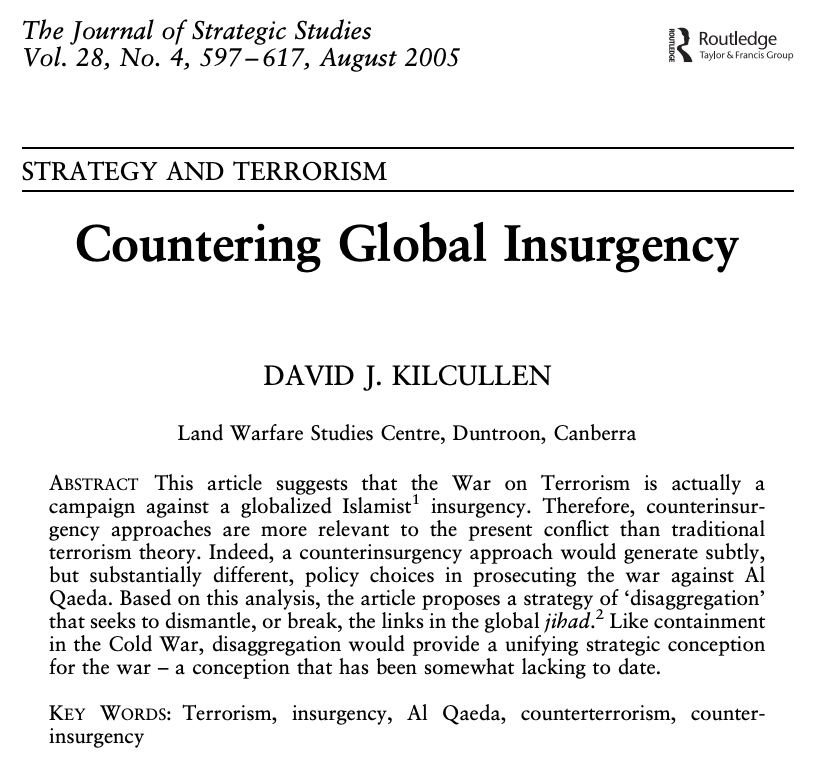] --- # Introduction .font130[ * It doesn't matter how we call the "war on terrorism": _it must be won_ * When the article was published (2005), Al Qaeda operated cells in about 40 countries * Al Qaeda never had control over all "theatres of operations"; rather, other Islamist groups adopted their tactics * "Nine principal Islamist theatres have been identified, including the Americas; Western Europe; Australasia; the Iberian Peninsula and Maghreb (Muslim Northwest Africa); the Greater Middle East; East Africa; South and Central Asia; the Caucasus and European Russia; and South-east Asia" (p. 599) * America, Western Europe, and Australia had active insurgents ] --- # Introduction * Terrorist attacks occur on the "civilisational frontiers" (Huntington?) .center[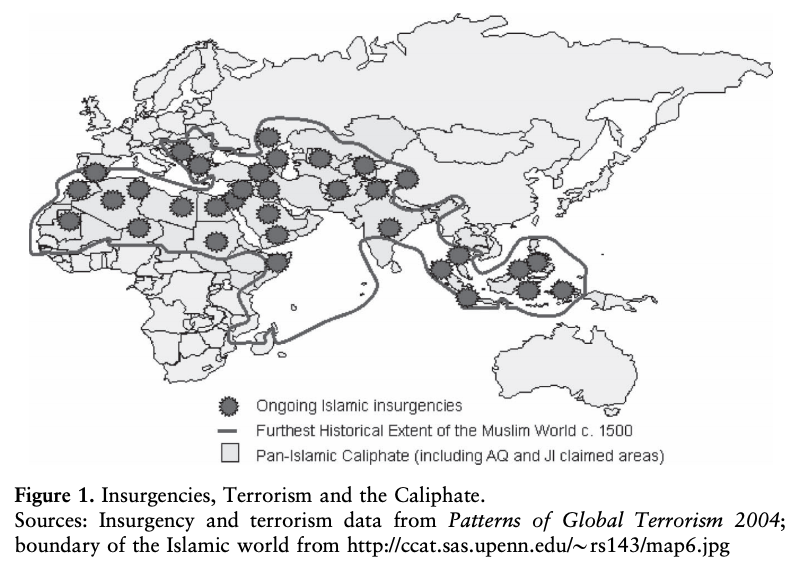] --- # Introduction .font150[ * Islamist groups are connected through family or social ties * Groups provide financial and logistic support for each other in the terrorist network, with Al Qaeda being the main source of funding and expertise * Many groups have little to do with the recent wave of Pan-Islamism, sometimes predating it by centuries * According to Kilcullen, this network of interconnected groups form a _global jihadist insurgency_ ] --- # Global Islamist insurgency .font140[ * Jihadists are not regular terrorists; they represent _a global insurgency_ - Insurgency: "a popular movement that seeks to overthrow the status quo through subversion, political activity, insurrection, armed conflict and terrorism" (p. 603) * Kilcullen states that terrorism is _a tool_ and that many terrorist groups have insurgent objectives * Al Qaeda resembles the Communist International: a movement dedicated to world revolution * Although terrorist methods are unacceptable, their demands are often seen as legitimate by the public * The objective should be _to defeat the insurgents' strategy_, not only to arrest or kill them ] --- # Counterinsurgency _redux_ .font150[ * **How to win the war on global terrorism?** * "We seek to defeat insurgents through ‘winning the hearts and minds’ of the population, a process that involves compromise and negotiation." (p. 605) * Counterinsurgency was originally designed to fight local guerrilla groups, not global insurgencies * There is no world government able to gather information, use force, and control all counter-insurgent actions * If one countries attempts to do so, it risks being seen as illegitimate ] --- # Aggregation and disaggregation .font140[ * So far, the American counter-terrorist strategy has been one of _aggregation_: Lump all terrorist groups together * This strategy creates new enemies and undermines US plans in the long run * _Disaggregation strategy_: one should fight the jihadist insurgency by breaking the links that make it global * Two conditions for the disaggregation strategy to work: - Break only the elements that make the jihad global - Deal with local insurgencies separately ] --- # Aggregation and disaggregation .font150[ * Re-conceptualisation of the War on Terror as a three-tier campaign at the global, regional and local levels * It shouldn't be a negative campaign against the jihadists, but a _positive campaign in favour of the international system_ ] --- # Goals .center[] --- # Conclusion: A constitutional path .font130[ * An important part of Kilcullen's strategy is to address the grievances of the Muslim population * "[...] exporting elements of the Malaysian and Turkish approaches to representative government in Muslim societies; addressing the role of women, education and governance; and building effective representational bodies for the world's Muslims. Measures like the Middle East Free Trade Zone, the Broader Middle East and North Africa Initiative, and the proposals canvassed in the UNDP's Arab Human Development Report" (p. 612) * **Questions**: how feasible are those goals? What is the relationship between Kilcullen's goals and state building? What is the role of "winning hearts and minds" in his strategy? ] --- # Winning hearts and minds .center[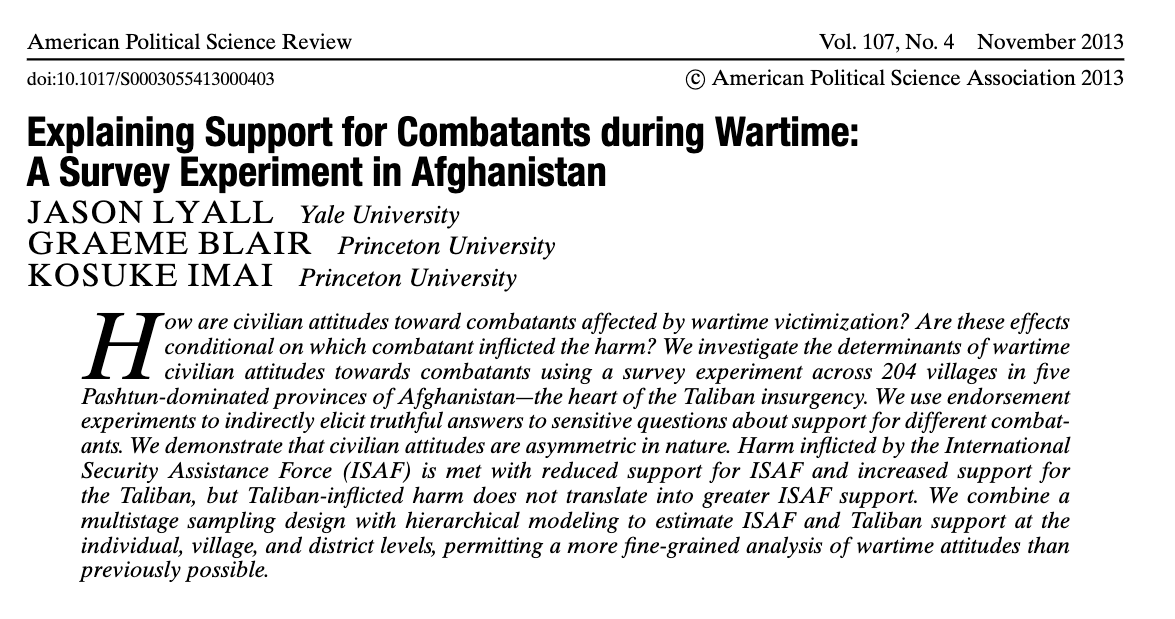] --- # Introduction .font150[ * As we've just seen, the relative success of a terrorist group relies on the amount of support they receive from the local population * Counter-terrorism is based on the same idea: foreign countries need to win "the hearts and minds" of the public * But how? Or even worse, is it even _possible_ to do so? * Lyall and his colleagues run a series of experiments in Afghanistan to find out ] --- # The rational peasant .font150[ * The literature has assumed that the population follows the group that is winning the combat * Since civilians are often coerced by such groups, the public allegedly tries to minimise exposure to harm and to maximise benefits * At least in theory, they are treated as having no clear preference of rulers: the public only makes cost-effective decisions * This is a simplistic assumption and does not hold well in practice * _Identity matters even in wars_ ] --- # Intergroup bias .font150[ * The authors claim that ethnic bias does not disappear even under extreme circumstances * Civilians evaluate the actions of their own group as motivated by necessity, while foreigners are motivated by less noble goals, such as greed * Ethnicity is a major source of in-group bias: - Ethnicity serves as a proxy for unobservable characteristics, mainly trust - Moderates believes about _past actions_ too, such as previous acts of violence * But how can we measure in-group bias if the public is not allowed to speak freely? ] --- # Methods: endorsement experiments .font150[ * Observational data, such as interviews of survey questionnaires, tend to be biased when there is risk for the respondent to be honest * For instance, if a respondent knows she will be retaliated by telling the truth, surveys will overestimate the support for the local/national leader * Lying is a rational strategy in situations where confrontation is costly * Example: voting in authoritarian countries ] --- # Methods: endorsement experiments .font150[ * Endorsement experiments evaluate civilian support indirectly * Instead of asking respondents if they are in favour or against a certain group, the interviewer asks their support for a _policy sponsored by the group_ * The interviewer then contrasts the endorsed policy with a baseline (no group mentioned) * The difference between the treatment group (endorsement) and the control group (no mention) provides evidence of support for the endorsing group ] --- # Example .pull-left[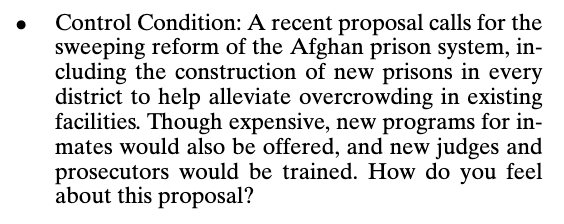] .pull-right[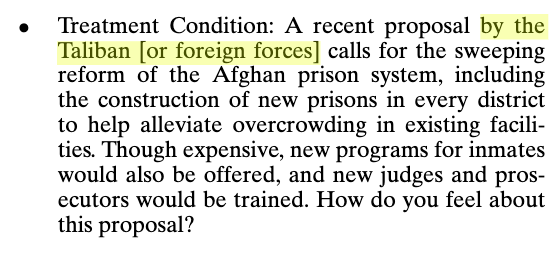] --- # Methods: endorsement experiments .font140[ * The authors asks 4 questions to measure the support for the American forces and for the Taliban - Prison reform; direct voting for district councils; support for reform of Afghanistan’s Independent Election Committee; support for strengthening the Office of Oversight for Anti-Corruption * Respondents used a standard 5-point Likert scale ("strongly agree" to "strongly disagree") ] --- --- # Results .center[] --- # Measuring exposure to violence .font140[ * Then, the authors use a statistical model to infer the relationship between exposure to violence and support for the Taliban and ISAF * _A lot_ of respondents said they were victimised in the war: - 37% of respondents indicated that they had personally experienced victimisation by ISAF - 33% acknowledged Taliban victimisation - 19% of respondents reported that they had been victimised by both combatants - 70% of respondents had heard of ISAF harming civilians in their _manteqa_, while about 40% had similarly heard of Taliban-inflicted harm in their area over the past year ] --- # Results .center[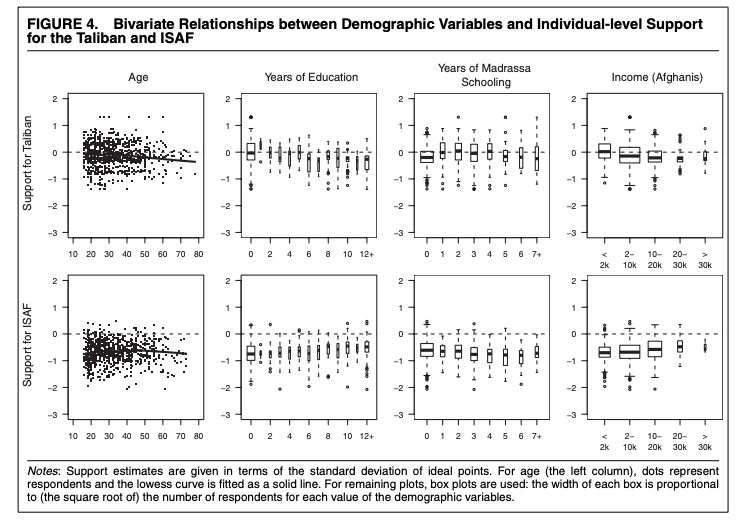] --- # Results .center[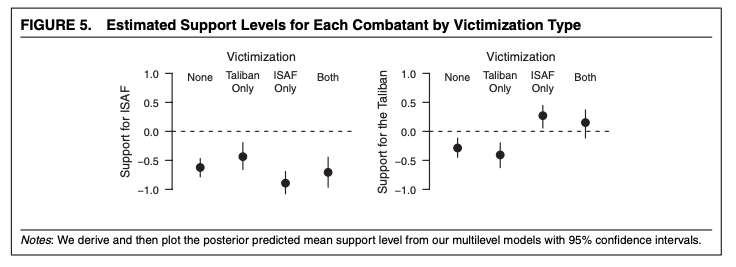] --- # Results .center[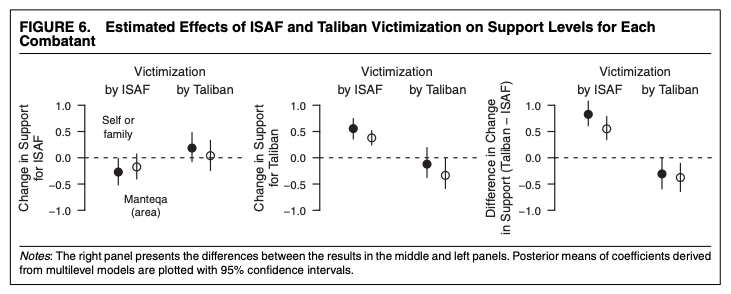] --- # Results .center[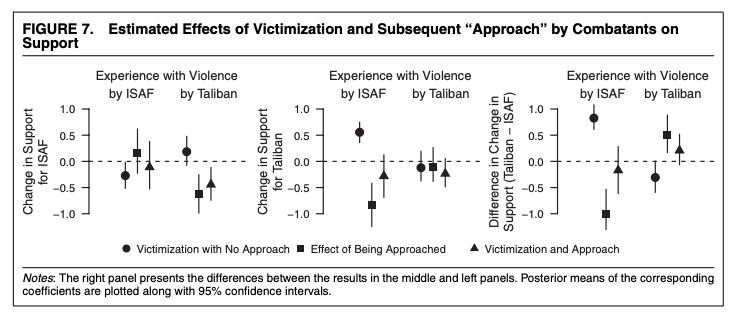] --- # Discussion .font150[ * Civilians show in-group bias even in extreme circumstances * ISAF violence is associated with negative effects on attitudes towards ISAF * But victimisation by the Taliban does not produce a similar negative effect * These effects are true even after controlling for victimisation or efforts to provide economic aid * ISAF has probably _reinforced_ in-group preferences in Afghanistan ] --- # Discussion .font140[ * Rebels are often forgiven by their mistakes in the conduction of war * Violence has heterogeneous effects, and it is unclear how local populations will perceive foreign presence in their territory * **Questions**: - What are the implications of these findings for Kilcullen's theory? - Which suggestions would you give to ISAF to improve its image in Afghanistan? - What about top-down approaches to state building? ] --- # Assassinations .center[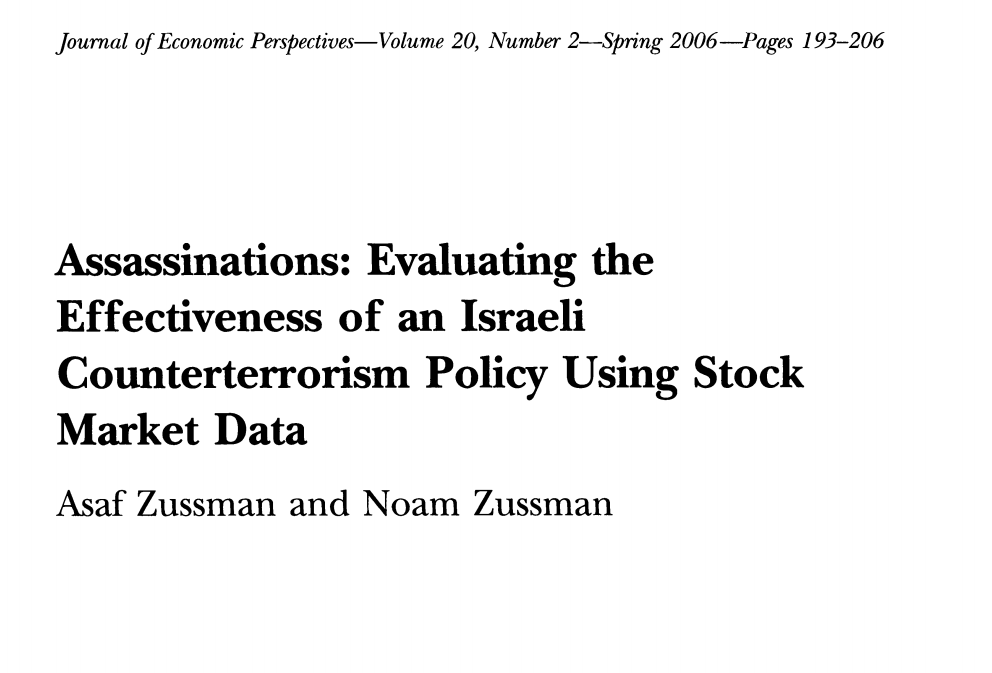] --- # Introduction .font150[ * Since "winning hearts and minds" is difficult, what could countries do in the meantime (or instead)? * One alternative is targeting terrorists and killing them pre-emptively * Is assassinating terrorists an effective policy? ] --- # Introduction .font140[ * Terrorist attacks have had adverse effects on the Israeli economy * But it is difficult to imagine how Israel's GDP would be without the terrorist attacks * As other counter-terrorist policies were implemented together with the assassinations, it is hard to isolate the effect of target killings * One solution is to use the stock market as a proxy for economic optimism, as it expresses forward-looking expectations about the state of the economy ] --- # Impact of terrorism on GDP .center[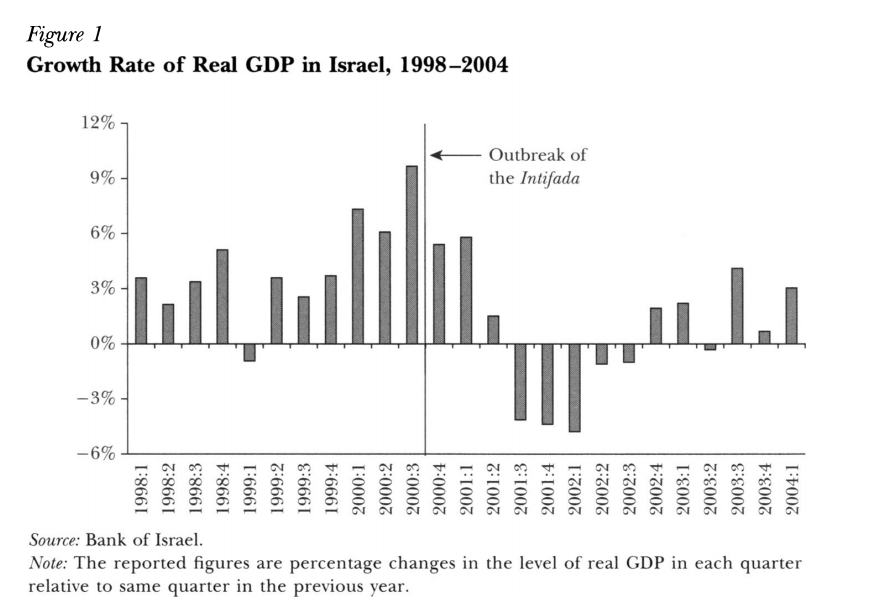] --- # Descriptive statistics .center[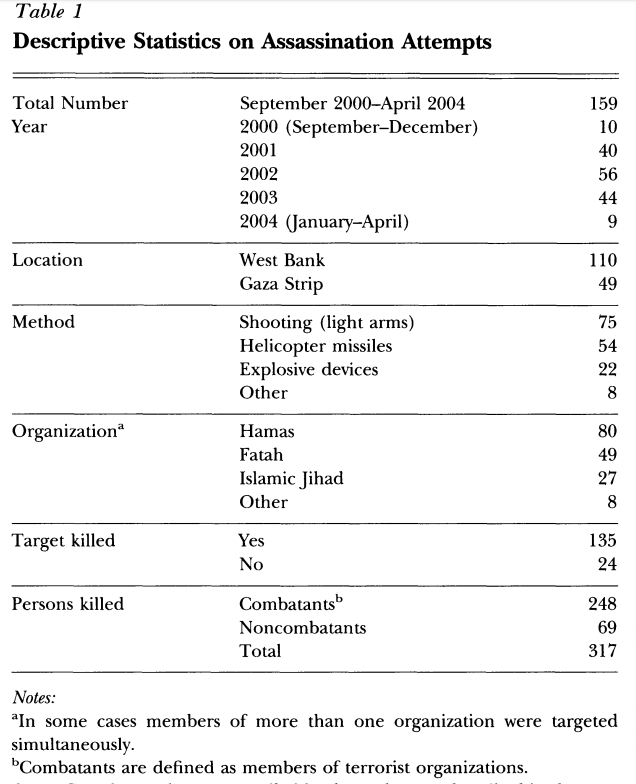] --- # Expected outcomes .font140[ * Killing senior members will likely be more effective in reducing terrorist violence, yet it also increases the chances of retaliation (p. 196) * Killing a military commander causes more disruption to a terrorist organisation than killing a political or spiritual leader * The authors used expert knowledge to classify the killed individuals - Least-restrictive classification: only one expert classifies the target as member of a political wing; intermediate approach, if two experts do so; and most-restrictive if all four experts agree ] --- # Results .center[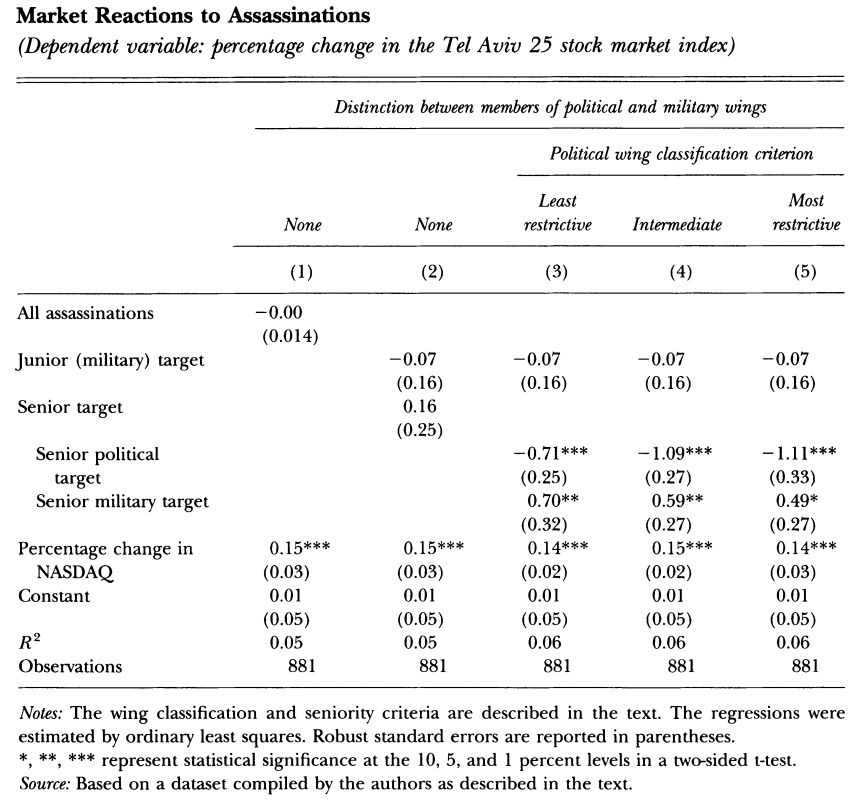] --- # Results .center[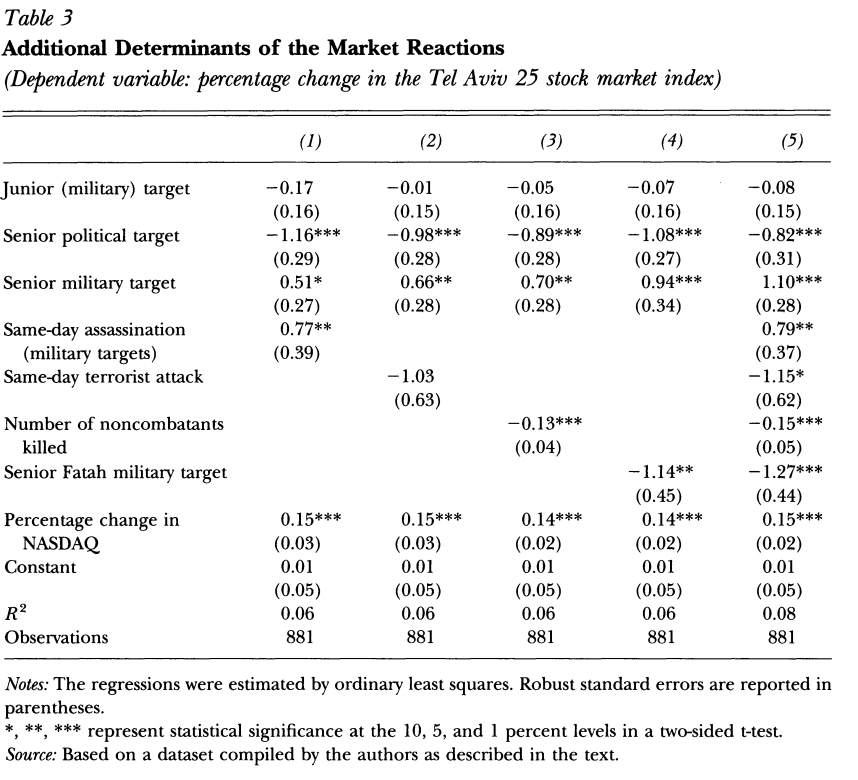] --- # Results .center[] --- # Results .center[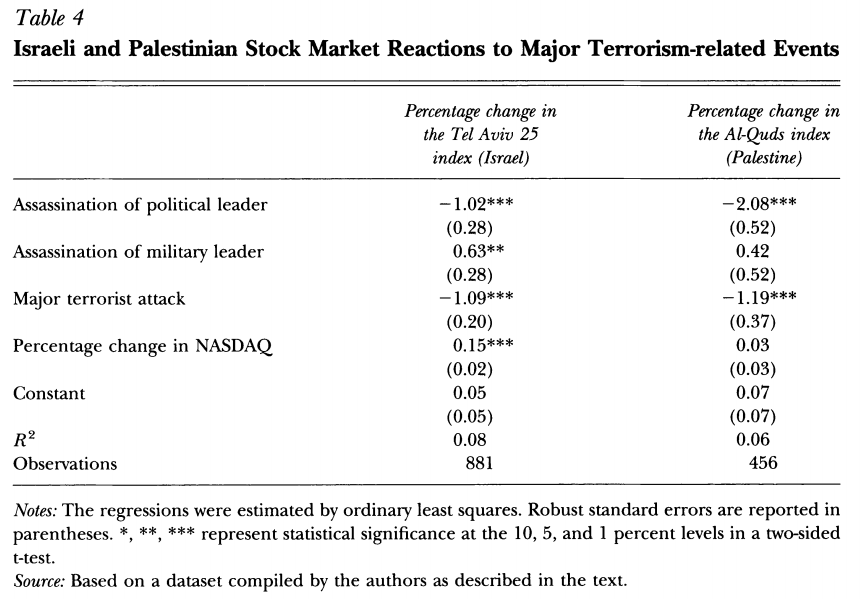] --- # Discussion .font150[ * On average, the market does not react to assassinations * But when the authors disaggregate the data, we see some interesting patterns * Negative reaction to the assassination of senior political targets * But positive reaction to the assassination of senior military targets ] --- # Discussion .font150[ * The effect of a terrorist attack simultaneously with an assassination is strongly negative, although significant only in the last model * The stock market reacts more negatively to assassination attempts against Fatah military leaders * The effects seem to last for quite some time * The effects are largely similar in the Palestinian stock market (quite puzzling!) ] --- # Conclusion .font150[ * Global terrorism is different from local terrorism * One way of addressing global terrorism is to treat it as an insurgency, that is, by taking their root causes seriously * Winning "hearts and minds" should be the goal of the US counter-terrorism policy * But it is _very_ hard to achieve * Local populations have strong in-group bias and react strongly against foreign presence ] --- # Conclusion .font150[ * But despite this apparently bad news, the idea of combining international, regional, and local levels seems promising * Evidence also shows that the market responds favourably to target killings, especially of senior military leaders * Perhaps both strategies, support for the population while targeting potential attackers, can be combined successfully ] --- class: inverse, center, middle # Main takeaways from this course <html><div style='float:left'></div><hr color='#EB811B' size=1px width=800px></html> --- # Wrap-up .font150[ * We've discussed some of the most important texts in the political violence literature * We've learned why and how insurgent groups rebel, why states attack their own citizens, and whether terrorism works * Violence is a difficult topic to analyse, but it is one of the few subjects where academic impact can be very large * So what are some of the conclusions we take from this course? ] --- # Wrap-up .font150[ * The world is richer and more peaceful than ever before * Civil wars are becoming more rare, genocides are less common, and terrorist organisations can be fought * Civil wars occur in poor, ethnically-fragmented countries, and rebel violence follows a rational logic. PKOs are also becoming more effective * Genocides are a sad feature of the 20th century, and are even harder to predict and act upon than civil wars. But they also happen less often that they used to ] --- # Wrap-up .font140[ * Terrorism has a long history, from the French Revolution to ISIS * While suicide terrorism works in the short run, non-violent resistance movements are far more likely to achieve their long-term goals * Counter-terrorism is still an open area of research, yet we have reasons to be hopeful: Many large terrorist groups have been defeated in the last decades * Yet, peace is always fragile and should never be taken for granted * So when darker days come (and they will eventually come), remember those words from [Hans Magnus Enzensberger](https://books.google.com/books/about/Civil_Wars.html?id=u3jjPQAACAAJ): ] --- # Sisyphus' stone .font120[ _"After all the destruction, the real heroes of the civil war step forth. They are late to arrive. Their entrance is unheroic. They don't stand out. They won't be on television. The persistence of these people is close to miraculous. They know they cannot put the world to rights. Only a corner of it---a roof, a wound._ _Writers wanted to make Sisyphus an existential hero, an outsider and a rebel of tragic proportions, larger-than-life and crowned in diabolical glory. Perhaps that is wrong. Perhaps he was something much more important, an everyday figure. He wasn't a philosopher, he was a trickster. Sisyphus overcame death and managed to return to earth. They say he reached a ripe old age. Later, as a punishment for his human understanding, he was condemned to push a heavy boulder up the side of a hill for the rest of time._ _The name of this stone is peace."_] --- class: inverse, center, middle # Thank you very much! :) <html><div style='float:left'></div><hr color='#EB811B' size=1px width=800px></html>